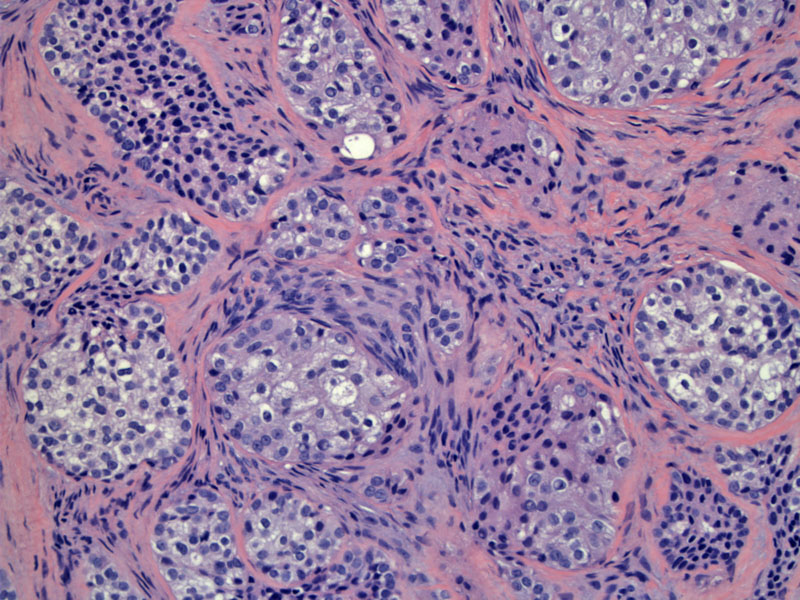

Packets of clear cells are separated by a fibrous stroma.
The epithelioid cells forms small nests and cords. The cells are embedded in a densely hyalinized background.
The neoplastic cells have clear to mildly eosinophilic cytopasm cytoplasm, moderately enlarged nuclei, only rare mitotic figures (not shown). The cells are rather uniform.
Infiltrative growth can be appreciated.
The anastomosing cords form almost a reticular pattern in the dense sclerotic stroma.
CT scan shows a cavitary left anterior mandibular mass with central necrosis (arrow).
It is again seen on PET scan which shows a FDG avid lesion in this area.
Another PET view demonstrating the anterior mandibular lesion. This is the favored location for the tumor.
Clear cell odontogenic carcinoma (previously known as clear cell ameloblastoma) is a very rare tumor. Less than 100 cases reported in the literature thus far, and it is defined as malignant epithelial odontogenic tumor composed predominantly of clear cells.
Histologically, the CCOC is characterized by islands and cords of epithelioid clear cells within a fibrous stroma. The stroma may form broad hyalinized bands, lending an organoid appearance to the tumor. The epithelial cells have clear to finely granular, glycogen-rich cytoplasm. The cell borders are well-defined, and the nuclei are vesicular to hyperchromatic. There may be focal palisading of basal cells, similar to ameloblastic epithelium. Occasionally, there is a second population of more eosinophilic or basaloid cells forming cords and islands within the clear cells, lending a "biphasic" appearance.
Immunohistochemically, the epithelioid cells are positive for pan-cytokeratins, CK14, CK19 and EMA, but negative for S100, SMA, desmin, HMB45.
The differential diagnosis includes: calcifying epithelial odontogenic tumor (amyloid deposits and calcifications), mucoepidermoid carcinoma (rarely composed of all clear cells) and metastatic renal cell carcinoma (CD10, PAX2 and RCC positive)(Zhang, Thompson).
Mean age is the fifth decade with a wide age range (17-90). There is a female predilection (2:1), and 75% of cases arise in the mandible, especially the anterior mandible. Symptoms include swelling, loosening of teeth and pain due to a destructive mass.
This is an aggressive tumor with a high recurrence rate and frequent metastases to the lungs (via lymphatics).
Thompson LDR, Wenig BM, eds. Diagnosis Pathology: Head and Neck. 1st Ed. Manitoba, Canada; Amirsys;2011; 6, 71-2.
Zhang J, et al. Clear cell odontogenic carcinoma: report of 6 cases and review of the literature. Med Oncol (2011) 28:S626-S633.